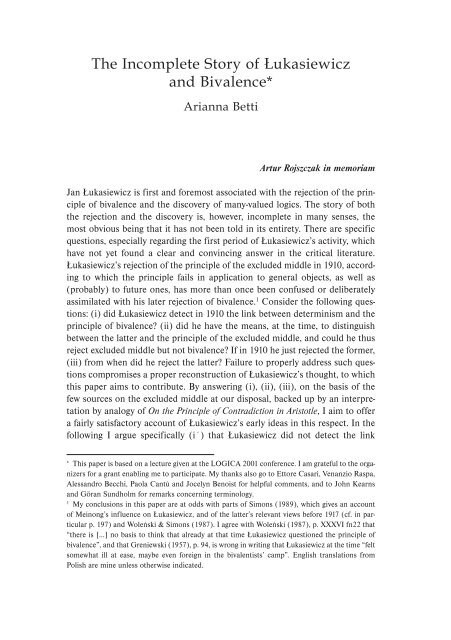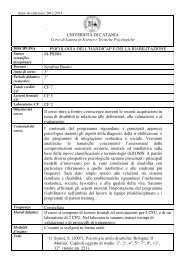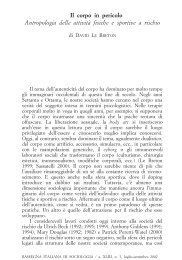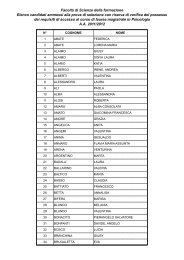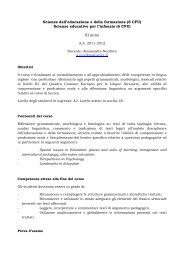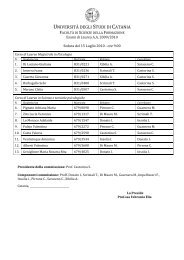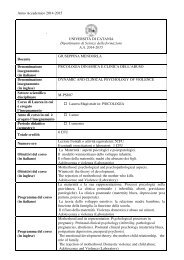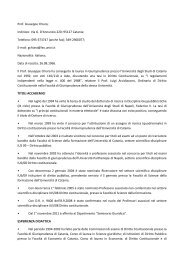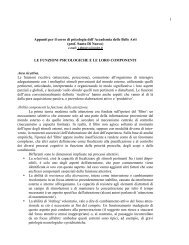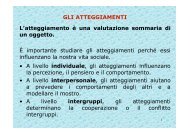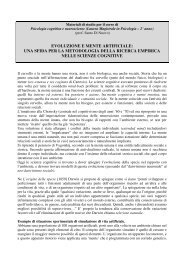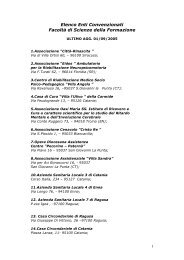The Incomplete Story of Åukasiewicz and Bivalence*
The Incomplete Story of Åukasiewicz and Bivalence*
The Incomplete Story of Åukasiewicz and Bivalence*
You also want an ePaper? Increase the reach of your titles
YUMPU automatically turns print PDFs into web optimized ePapers that Google loves.
<strong>The</strong> <strong>Incomplete</strong> <strong>Story</strong> <strong>of</strong> Łukasiewicz<strong>and</strong> <strong>Bivalence*</strong>21Arianna BettiArtur Rojszczak in memoriamJan Łukasiewicz is first <strong>and</strong> foremost associated with the rejection <strong>of</strong> the principle<strong>of</strong> bivalence <strong>and</strong> the discovery <strong>of</strong> many-valued logics. <strong>The</strong> story <strong>of</strong> boththe rejection <strong>and</strong> the discovery is, however, incomplete in many senses, themost obvious being that it has not been told in its entirety. <strong>The</strong>re are specificquestions, especially regarding the first period <strong>of</strong> Łukasiewicz’s activity, whichhave not yet found a clear <strong>and</strong> convincing answer in the critical literature.Łukasiewicz’s rejection <strong>of</strong> the principle <strong>of</strong> the excluded middle in 1910, accordingto which the principle fails in application to general objects, as well as(probably) to future ones, has more than once been confused or deliberatelyassimilated with his later rejection <strong>of</strong> bivalence. 1 Consider the following questions:(i) did Łukasiewicz detect in 1910 the link between determinism <strong>and</strong> theprinciple <strong>of</strong> bivalence? (ii) did he have the means, at the time, to distinguishbetween the latter <strong>and</strong> the principle <strong>of</strong> the excluded middle, <strong>and</strong> could he thusreject excluded middle but not bivalence? If in 1910 he just rejected the former,(iii) from when did he reject the latter? Failure to properly address such questionscompromises a proper reconstruction <strong>of</strong> Łukasiewicz’s thought, to whichthis paper aims to contribute. By answering (i), (ii), (iii), on the basis <strong>of</strong> thefew sources on the excluded middle at our disposal, backed up by an interpretationby analogy <strong>of</strong> On the Principle <strong>of</strong> Contradiction in Aristotle, I aim to <strong>of</strong>fera fairly satisfactory account <strong>of</strong> Łukasiewicz’s early ideas in this respect. In thefollowing I argue specifically (i´) that Łukasiewicz did not detect the linkThis paper is based on a lecture given at the LOGICA 2001 conference. I am grateful to the organizersfor a grant enabling me to participate. My thanks also go to Ettore Casari, Venanzio Raspa,Aless<strong>and</strong>ro Becchi, Paola Cantù <strong>and</strong> Jocelyn Benoist for helpful comments, <strong>and</strong> to John Kearns<strong>and</strong> Göran Sundholm for remarks concerning terminology.1My conclusions in this paper are at odds with parts <strong>of</strong> Simons (1989), which gives an account<strong>of</strong> Meinong’s influence on Łukasiewicz, <strong>and</strong> <strong>of</strong> the latter’s relevant views before 1917 (cf. in particularp. 197) <strong>and</strong> Woleński & Simons (1987). I agree with Woleński (1987), p. XXXVI fn22 that“there is […] no basis to think that already at that time Łukasiewicz questioned the principle <strong>of</strong>bivalence”, <strong>and</strong> that Greniewski (1957), p. 94, is wrong in writing that Łukasiewicz at the time “feltsomewhat ill at ease, maybe even foreign in the bivalentists’ camp”. English translations fromPolish are mine unless otherwise indicated.
<strong>The</strong> <strong>Incomplete</strong> <strong>Story</strong> <strong>of</strong> Łukasiewicz <strong>and</strong> Bivalence 23importance to historians, not least because it is not yet marked by Łukasiewicz’slater metalogical interests, which played a substantial role in the metalogicalturn in Pol<strong>and</strong> as a whole.I. Bivalence, ontological Tertium non datur<strong>and</strong> logical Tertium non daturIn a talk on the principle <strong>of</strong> the excluded middle from 1910, Łukasiewiczclaimed that the principle <strong>of</strong> the excluded middle fails to obtain in applicationto general objects <strong>and</strong> (probably) to future objects. 7 In his paper on Łukasiewicz<strong>and</strong> Meinong Peter Simons observes that this means that (a) Łukasiewiczhad detected as early as 1910 the link between determinism <strong>and</strong> bivalence– which is notoriously Łukasiewicz’s reason for rejecting classical logic 8– because (b) he <strong>and</strong> others did not distinguish at that time bivalence from theexcluded middle. <strong>The</strong>se claims seem to suppose that we should take Łukasiewicz’s1910 excluded middle to be(1) D ›Dwhere D is a schematic letter st<strong>and</strong>ing for sentences. If this were Łukasiewicz’sexcluded middle, it would be true that neither he nor his contemporaries couldactually distinguish (1) from the metalogical principle <strong>of</strong> bivalence (metalogicin the usual sense was still to come). 9 However, what Łukasiewicz had in mindwhen speaking <strong>of</strong> the excluded middle was not (1).Here three things are at issue: the principle <strong>of</strong> bivalence, the ontologicalprinciple <strong>of</strong> the excluded middle <strong>and</strong> the logical principle <strong>of</strong> the excluded middle.In his monograph On the Principle <strong>of</strong> Contradiction in Aristotle (1910)Łukasiewicz was the first in the Polish tradition to clearly distinguish betweenontological <strong>and</strong> logical principles. 10 By analogy with Łukasiewicz’s distinctionbetween the different versions <strong>of</strong> the principle <strong>of</strong> contradiction, which he elaboratedwith reference to Aristotle, the two versions <strong>of</strong> the principle <strong>of</strong> excludedmiddle, ontological <strong>and</strong> logical, can be reformulated as follows:OTNDLTNDEvery object a has either the property b or else non-b;Two sentences <strong>of</strong> the form, respectively, ‘the object a hasthe property b’ <strong>and</strong> ‘the object a has the property non-b’ arenot both false at the same time.7Cf. Łukasiewicz (1910b).8Cf. Łukasiewicz (1918) <strong>and</strong> (1922/3).9Cf. DeVidi & Solomon (1999) on the confusions about bivalence <strong>and</strong> the excluded middle.10Cf. Łukasiewicz (1910a), pp. 9 <strong>and</strong> ff; Germ. transl. p. 9 <strong>and</strong> ff.
24Arianna BettiŁukasiewicz considered OTND <strong>and</strong> LTND to be equivalent. 11 <strong>The</strong>se formulations,in a somewhat more ambiguous <strong>and</strong> general form, became also st<strong>and</strong>ardin the Polish milieu for some time, being employed by Leśniewski in particular.12 Another encoding <strong>of</strong> the principle, proposed by Łukasiewicz in theAppendix to the Principle <strong>of</strong> Contradiction in Aristotle, is(2) a+a´=1.Principle (2), written in the style <strong>of</strong> Louis Couturat’s L’Algèbre de la logique,reads: “either the object a has the property b or the object a does not have theproperty b iff a is an object”. 13 <strong>The</strong> fact that (2) has this particular biconditionalformulation is irrelevant for our purposes here. 14 <strong>The</strong> crucial point instead isthat a+a´ in (2) is just another way <strong>of</strong> writing OTND: the negation a´ in (2) isnot the sentential negation most philosophers are familiar with, that <strong>of</strong> (1), butterm negation, also called nominal or predicate term negation. 15 If we disregardthat Łukasiewicz adopts the Bolzanian form <strong>of</strong> truth-bearers, i. e. ‘a has b-ity’(e. g., ‘Tommy has happiness’), <strong>and</strong> not the traditional ‘a is b’ (e. g., ‘Tommy ishappy’), an uninteresting difference here, we can observe the following. In Leśniewski’stheory <strong>of</strong> semantic categories, where with s <strong>and</strong> n the two basic categories<strong>of</strong> sentences <strong>and</strong> names are indicated, ‘@’ in (1) is a sentence-formingfunctor <strong>of</strong> one sentential argument (category: s/s), while the negation in (2),which could be described rather as a negative copula ‘is-not’, is a sentenceformingfunctor which takes two names as arguments (category: s/nn). In thecontext <strong>of</strong> the present discussion ‘a is-not b’ is equivalent to ‘a is non-b’, wherethe nominal negation ‘non-’ is a name-forming function taking a name as anargument (category: n/n). It is not, however, equivalent to ‘not: A is b’ (@). Asis usually the case in Łukasiewicz’s early writings (<strong>and</strong> in Leśniewski’s), the11Cf. Łukasiewicz (1910a), p. 149: “for true judgments, positive <strong>and</strong> negative, correspond to objectivefacts, that is to the relations <strong>of</strong> possessing <strong>and</strong> not possessing a property by an object”; Germ.transl. p. 183. In this work judgments are linguistic items.12Cf. for instance Leśniewski (1912), §1, p. 203 (Eng. transl. p. 21) <strong>and</strong> Leśniewski (1913), §1,p. 316 (Eng. transl. p. 48). Note however that for Leśniewski OTND <strong>and</strong> LTND are not equivalent:the first is true, the second false.13Łukasiewicz (1910a), pp. 155 <strong>and</strong> 170-1; Germ. transl. pp. 189, 212 <strong>and</strong> ff.14This is linked to a difference Łukasiewicz detects between a formal <strong>and</strong> a concrete pro<strong>of</strong> <strong>of</strong> fundamentallogical principles like the principle <strong>of</strong> contradiction, cf. Łukasiewicz (1910), p. 152;Germ. transl. p. 186. Cf. also Betti (200X) <strong>and</strong> Raspa (1999).15<strong>The</strong> distinction “comes in a discouraging array <strong>of</strong> guises”, cf. the impressive chart in Horn(1989), p. 140. Horn’s book is an indispensibile source <strong>of</strong> infomation on the topics discussed inthis section. ‘Predicate negation’ <strong>and</strong> ‘predicate term negation’ do not always st<strong>and</strong> for the samething. For ‘nominal negation’, cf. Henry (1972), p. 38; Wessel (1982), p. 1363, speaks <strong>of</strong> an Absprechenoperator.A parallel with von Wright’s strong <strong>and</strong> weak negation (1959) is probably appropriate,cf. Horn (1989), p. 132 <strong>and</strong> ff.
<strong>The</strong> <strong>Incomplete</strong> <strong>Story</strong> <strong>of</strong> Łukasiewicz <strong>and</strong> Bivalence 25negation in sentences <strong>of</strong> the form ‘a does not have b’ is term negation, so thatsuch sentences are in fact to be understood as having the form ‘a has non-b’.Sentential negation is instead normally expressed by the clause ‘is false’. 16Incidentally, notice that LTND concerns only singular sentences. For whenŁukasiewicz originally formulates the logical principle <strong>of</strong> contradiction hewrites:two judgments <strong>of</strong> which one ascribes to an object [przedmiotowi] just theproperty which the other denies to it [mu] cannot be true at the sametime. 17We obtain the logical principle <strong>of</strong> the excluded middle just by substituting‘false’ for ‘true’ in the passage above. Although it is enough for the present purposesto take into account only pairs <strong>of</strong> singular sentences, LTND could easilybe reformulated in order to hold also for quantified sentences. What isimportant is that the negation is understood as term negation <strong>and</strong> not accordingto the st<strong>and</strong>ard matrix <strong>of</strong> sentential calculus. Such reformulation <strong>of</strong> LTNDwould apply, for instance, to the following pair <strong>of</strong> sentences “All triangles areequilateral” <strong>and</strong> “Some triangles are non-equilateral”.In sum, neither (2), OTND nor LTND are equivalent to (1). As will beclearer in the following, it is precisely because <strong>of</strong> the way Łukasiewicz underst<strong>and</strong>snegation in OTND/LTND that bivalence is not at all what is involvedin his rejection <strong>of</strong> the principle <strong>of</strong> the excluded middle. ConsiderBIV<strong>The</strong>re are exactly two truth-values: true <strong>and</strong> false.Is the one who rejects OTND/LTND compelled to reject BIV? Definitelynot. Moreover, things do not change if one strengthens BIV by including alsothe determinacy claimDETEvery sentence has exactly one truth-valuein order to obtainBIV*Every sentence is either true or else false.16In the present context term negation is also not distinct from privation. Cf. also Bolzano (1837)§127, II 15: the negation <strong>of</strong> a property b is formulated as ‘lack <strong>of</strong> b(-ity)’, as in ‘a has lack-<strong>of</strong>-b(-ity)’, while the negation <strong>of</strong> a proposition ‘a has b-ity’ corresponds to ‘a has lack-<strong>of</strong>-truth’ – wherelack-<strong>of</strong>-truth is taken to be falsity.17Cf. Łukasiewicz (1910a), p. 11, my emphasis; Germ. trans. p. 11.
<strong>The</strong> <strong>Incomplete</strong> <strong>Story</strong> <strong>of</strong> Łukasiewicz <strong>and</strong> Bivalence 27(1)-(2) <strong>and</strong> (3)-(4) are neither true nor false (in a semantics with truth-valuegaps, for instance), or reject BIV if you stated that they possess a third value. 21Also, to properly state BIV* one does not need anything more than takingtruth <strong>and</strong> falsity as properties <strong>of</strong> sentences, which are particular objects, <strong>and</strong>BIV* turns out to be the following special case <strong>of</strong> OTND:OTND*Every sentence has either the property truth or else non-truth,where non-truth equals falsity.II. Yes, but what about probability?In his 1913 paper on probability, however, Łukasiewicz claimed quite explicitlythat there are some sentences which invalidate OTND* (BIV*). But Łukasiewiczis likewise explicit on this: the sentences infringing BIV* are not sentenceslike (1)-(4). Łukasiewicz considers two kinds <strong>of</strong> sentences: determinedsentences (also called judgments), <strong>and</strong> undetermined sentences. Undeterminedsentences are a quite peculiar kind <strong>of</strong> sentences containing a free variable, like(5) x is an Englishman.Sentences like (1)-(4) are instead determined sentences, as they do not containany variable, like ‘W. H. Auden is an Englishman’. Sentences like (5) areonly apparently what we now call ‘open sentences’. 22 <strong>The</strong>y are rather thoughtto function like Bolzanian propositions-in-themselves in which some ideaspartsvary according to a certain rule (read: have a domain <strong>of</strong> variation), <strong>and</strong>so generating many other propositions <strong>of</strong> the same kind. For Bolzano thedegree <strong>of</strong> validity (Gültigkeit) <strong>of</strong> (5) is 1 if <strong>and</strong> only if all the propositions generatedfrom (5) by varying the subject-idea (in this case: the place-holder x) areall true; it is 0 if <strong>and</strong> only if all the propositions generated from (5) by varyingthe subject-idea are all false; <strong>and</strong> it is an intermediate value between 0 <strong>and</strong> 1 iffrom (5) true as well as false propositions are generated. <strong>The</strong> validity degree(for Łukasiewicz: logical value) is thus given by the ratio <strong>of</strong> all true propositionswhich are generated from a given proposition to all propositions that can possiblybe generated from it. 23 <strong>The</strong> reason why determined sentences in Łukasie-21I am presupposing here a clear difference between a sentence getting a truth-value other thantrue or false <strong>and</strong> a sentence not getting any (‘truth-valueless’), but the issue <strong>of</strong> what a truth-valuegap would exactly be does not seem uncontroversial. Cf. Glanzberg (200X), p. 3.22Cf. Childers & Majer (1998), p. 303.23Cf. Bolzano (1837), §147. Cf. also Jan Berg’s introduction to Bernard Bolzano-Gesamtausgabe,I/12, 1, p. 55.
28Arianna Bettiwicz’s view are just true or false <strong>and</strong> do not possess an intermediate valueseems to be that for them there is no ratio that can be established in this way.It is therefore particularly important to stress that for Łukasiewicz determinedstatements about future events are (now) either true or false, even if before theevent we cannot know which ones are true <strong>and</strong> which ones are false:It can no longer be asserted that such events or sentences as ‘This die willnow turn up 6’ or ‘the next drawing from this urn will yield a black ball’ areprobable. Such sentences, being determined judgements, are either true orfalse, even if before the event we can never know which <strong>of</strong> them are true <strong>and</strong>which are false. 24This tells us how far Łukasiewicz was at this point from his later approachlinking future contingents <strong>and</strong> a third kind <strong>of</strong> (determined!) sentences. First,the difference between determined <strong>and</strong> undetermined sentences in the senseexplained above ceased to play any role in his post-1917 works. Secondly, wecan easily modify OTND* substituting ‘sentence’ by ‘determined sentence’ inorder we picture better Łukasiewicz’s views in 1913:OTND** Every determined sentence is either true or false.Now it is easy to see that Łukasiewicz accepted OTND** up to 1917, but itis exactly OTND** which he later rejected. <strong>The</strong> picture at this point can besummed up as follows. If future objects enjoy the same status <strong>of</strong> generalobjects, i. e., are as undetermined as to some properties as general objects are,then (as stated in 1910) both(6) ‘the next ball to be extracted from this box will be black’<strong>and</strong>(7) ‘the next ball to be extracted from this box will not be black’are false. This is a counterexample to LTND, as negation in (7) is understoodlike in (4) as predicate negation. Still, this would have nothing to do with rejectingBIV*, because (6) <strong>and</strong> (7) would not have a third value. It is clear that atthis particular time <strong>of</strong> Łukasiewicz’s development no determined sentence canbe neither true nor false. As this is stated also in his 1916 paper on the concept<strong>of</strong> magnitude, which fully squares with Łukasiewicz’s ideas on probability, 25 it24Łukasiewicz (1913), p. 34; Eng. trans. p. 38, here quoted with slight changes.25Cf. Łukasiewicz (1916), p. 311; Eng. trans. p. 71.
<strong>The</strong> <strong>Incomplete</strong> <strong>Story</strong> <strong>of</strong> Łukasiewicz <strong>and</strong> Bivalence 29turns out that 1917 can indeed be used to establish a chronology. 26 We have noreasons to be puzzled by the fact that later, in 1930, Łukasiewicz played downany connection between the rejection <strong>of</strong> bivalence <strong>and</strong> his 1913 theory <strong>of</strong> probability.27 Further, if it were per absurdum true that Łukasiewicz introduced thethird value in connection with his 1913 paper on probability, then we would befully justified in claiming that the third value was present in 1909 already, sincea short piece from 1909 shows that Łukasiewicz’s 1913 ideas on probabilitywere already ripe in that year. 28 This latter circumstance, incidentally, alsoweakens the hypothesis <strong>of</strong> an influence on Łukasiewicz <strong>of</strong> Meinong’s theory <strong>of</strong>probability. 29 And it can be shown on the basis <strong>of</strong> a textual analyses that thestrongest influence on Łukasiewicz’s theory <strong>of</strong> probability was rather exertedby Bernard Bolzano.III. Objection!Some may still not feel convinced by the story as I tell it. <strong>The</strong>re is indeed atleast one passage from 1910 in which Łukasiewicz says that statements aboutgeneral objects are neither true nor false:Let us consider the object “column in general” without any further definition.[…] Should we consider a judgment such as ‘the column is sharp’ trueor false? […] the judgment ‘the column is sharp’ is neither true nor false. 30This passage comes from the book on contradiction <strong>and</strong> was written beforethe 1910 talk on OTND/LTND. Should we then think that roughly in the sameperiod Łukasiewicz thought that statements about general objects are false(talk) <strong>and</strong> that they are neither false nor true (book), <strong>and</strong> therefore that afterall he did not distinguish OTND/LTND from BIV*? No, we should not.Compare the footnote attached to the passage quoted above:I accept here for the moment Meinong’s view. However, a question arises:should we not consider judgments <strong>of</strong> this kind, like “the column is sharp”,“the column is not sharp”, “the triangle is equilateral”, “the triangle is not26Contra Sobociński (1956/7), p. 29: “in the scientific activity <strong>of</strong> Pr<strong>of</strong>. Łukasiewicz one can distinguishtwo periods: the Lvov period, lasting until 1915, <strong>and</strong> the Warsaw period, starting from thatyear”.27Cf. Łukasiewicz (1930), p. 113; Eng. trans. p. 173.28Cf. Łukasiewicz (1909), p. 231.29Simons (1989), p. 204, <strong>of</strong>fers reasons pro <strong>and</strong> contra, but in his diary Łukasiewicz deniedMeinong’s influence, cf. Łukasiewicz (1949/54), p. 61-61v.30Łukasiewicz (1910a), p. 113; Germ. transl. p. 138.
30Arianna Bettiequilateral” <strong>and</strong> so on, false anyway? This question is linked with the principle<strong>of</strong> the excluded middle, which constitutes, as is known, a counterpartto the principle <strong>of</strong> contradiction. Should the judgments mentioned abovebe considered false, it would be a characteristic <strong>of</strong> incomplete objects thatthey do not fall under the principle <strong>of</strong> the excluded middle. 31Łukasiewicz, therefore, clearly detects the position in the passage, the oneaccording to which sentences like (1) <strong>and</strong> (2) are neither-true-nor-false, asMeinong’s, not as his own. Łukasiewicz instead states his position in the footnote.He simply does not specify his views in detail, but what he already mentionsin the footnote he was to state more firmly in the talk on the excludedmiddle. It is not difficult to tell why Łukasiewicz found it convenient to takesides with Meinong, as the mention <strong>of</strong> incomplete objects is fully Meinongian.Łukasiewicz, however, adds some remarks <strong>of</strong> his own as well: the triangle ingeneral is called, both in 1906 <strong>and</strong> in the book on contradiction, an abstractideal object, a construction or an object <strong>of</strong> construction, while the column in generalis called an abstract real object, a reconstruction or an object <strong>of</strong> reconstruction.32 Next to general objects like the column in general there are also concreteobjects, like the column Mickiewicz in Lvov. <strong>The</strong> salient difference betweenconcrete <strong>and</strong> abstract objects is what Łukasiewicz <strong>and</strong> Meinong would term adifference in completeness. A concrete object is a complete object, that is to say,OTND holds. Complete objects are things, properties, phenomena, events: theEiffel Tower is a complete object as it is determined in its most minute details.This is not the case with abstract objects (both real <strong>and</strong> ideal), which Łukasiewicztemerariously enough also calls concepts, which are, therefore, incompleteobjects. To constructions like the triangle in general nothing corresponds in theexternal world, while to reconstructions like the tower in general correspondssomething in the external world (namely particular colums). According toŁukasiewicz, reconstructions are <strong>of</strong> use in science exactly like concrete objects.Biochemistry <strong>and</strong> sociology do not just investigate particular nerve cells <strong>and</strong>revolutions, but also nerve cells <strong>and</strong> revolutions in general to which particularcells <strong>and</strong> revolutions correspond. <strong>The</strong>se general objects are complete withrespect to some properties, but incomplete with respect to other ones, whichcould namely be termed essentially complete <strong>and</strong> accidentally incomplete. A reconstructionlike the king in general has essentially a kingdom, but need not be aparticular one; on the contrary, if you ascribe to the king in general a particularkingdom, say, Spain, then you get a king <strong>of</strong> Spain in general, but not a kingin general anymore. So it is false that the king in general has the property <strong>of</strong>being a king <strong>of</strong> Spain. But given this, you are not entitled to ascribe to the king31Ibidem, footnote.32Cf. Łukasiewicz (1906), p. 15; Łukasiewicz (1910a), p. 114; Germ. transl. p. 140.
<strong>The</strong> <strong>Incomplete</strong> <strong>Story</strong> <strong>of</strong> Łukasiewicz <strong>and</strong> Bivalence 31in general the property <strong>of</strong> not being a/the king <strong>of</strong> Spain in the sense <strong>of</strong> OTND,because this would mean ascribing him a particular kingdom, say Sweden orMorocco, <strong>and</strong> the king in general is a general one exactly because it is notdetermined as to which kingdom he has, the number <strong>of</strong> hair he has on his head<strong>and</strong> so on. OTND is to be understood as saying this: for every property <strong>of</strong> acertain species, every object a has one <strong>of</strong> them (I here leave out what exactly aspecies would be).IV. Why did Łukasiewicz change his views?<strong>The</strong> introduction <strong>of</strong> the third value as in the first system <strong>of</strong> 1917, not to mentionthe metalogical way in which Łukasiewicz deals with it in the later threevaluedsystem <strong>of</strong> 1920 (possibly identical to the former), 33 had not yet beenmade in 1913. Before 1917 Łukasiewicz was still, though questioning OTND<strong>and</strong> LTND, inside bivalence. In 1913 he was even convinced that if a sentenceis undetermined <strong>and</strong> probable at any certain given time-point t, it is eternallyprobable, i.e., probable at any future time-point t 1 following t. But at a certainpoint Łukasiewicz ab<strong>and</strong>oned his previous ideas, starting to question bivalencefor determined sentences, <strong>and</strong> firmly rejecting the eternity conception for possibleones (as he sometimes liked to call the third kind <strong>of</strong> sentences). What madehim change his views? Since he already knew Meinong’s positions, we mightassume he could have realized only later the rich implications <strong>of</strong> Meinong’sviews. Other hypotheses are possible, though. <strong>The</strong> most probable is that Łukasiewicz’sturn was a result <strong>of</strong> the 1913 controversy about eternity <strong>and</strong> sempiternity<strong>of</strong> truth between Leśniewski <strong>and</strong> Kotarbiński. That Kotarbiński’s perspectivehad an influence on Łukasiewicz’s rethinking <strong>of</strong> the semantics <strong>of</strong>future contingents is something that scholars agree upon. 34 Kotarbiński madethe necessary step towards having another kind <strong>of</strong> sentences next to true <strong>and</strong>false, the ones he called indefinite <strong>and</strong> whose subjects denote what would beperfectly determined objects if they were present. <strong>The</strong> sole odd detail is thatŁukasiewicz in 1916 is still inside bivalence (but so was Kotarbiński, apparently).Only from 1917 onwards were sentences <strong>of</strong> whatever kind denoting a possibleobject (something that could be actualised only in the future) associatedwith a third value. <strong>The</strong> reason why Łukasiewicz’s turn took place only latermight depend on the fact that this new st<strong>and</strong>point required a change in perspectiveas to what is involved in a sentence’s truth-making. Up to 1917Łukasiewicz never linked undetermined statements with direct ‘undeterminedness-making’,so to speak: in his theory <strong>of</strong> probability some sentences got truth-33Simons (1989), p. 200, raises the question whether these are two systems or one.34See the discussion in Woleński (1990), p. 195.
32Arianna Bettivalues different from true <strong>and</strong> false as a result <strong>of</strong> their being related to othersentences, not as a result <strong>of</strong> an evaluation based on their truth-maker. But inKotarbinski’s paper indefinite sentences are such because they are about undetermined,i. e., possible, objects. 35 Although Łukasiewicz would also later speakabout possibilia, the turn immediately preceding the construction <strong>of</strong> the firstthree-valued system was probably also the last occasion on which Łukasiewiczwas specifically concerned with the theory <strong>of</strong> objects. In particular, althoughhis main work in the early period was concerned with a criticism <strong>of</strong> the principle<strong>of</strong> contradiction on an object-theory basis, starting from 1910 onwardsŁukasiewicz became less <strong>and</strong> less concerned with fighting the principle <strong>of</strong>which the excluded middle was a counterpart, the principle <strong>of</strong> contradiction inits ontological <strong>and</strong> logical versions.Łukasiewicz’s switch from ontology to logic <strong>and</strong> metalogic is in generalvery clear to see: it must be seen as associated with the dissemination <strong>of</strong> thesentential calculus in Pol<strong>and</strong> that took place during the First World War.Woleński is right that Łukasiewicz’s courses in logic before 1917 cannot haveexceeded the level <strong>of</strong> Couturat’s book on the algebra <strong>of</strong> logic. 36 <strong>The</strong>re is a quotationin print from Łukasiewicz’s diary in which he says that although he startedlecturing on logic in 1906, he occupied himself with mathematical logiconly later <strong>and</strong> between the wars – <strong>and</strong> he is obviously speaking <strong>of</strong> his post-1917systems. 37 Now, when Łukasiewicz rejected bivalence metalogically, i. e., insertinginto the logical matrix <strong>of</strong> the bivalent propositional calculus the value ‘2’,he obtained a trivalent matrix for a trivalent calculus in which both (1) <strong>and</strong>(8) @(a š@a)got the third value for a getting the third value. Until the rejection <strong>of</strong> bivalenceŁukasiewicz was only able to challenge the principles <strong>of</strong> contradiction <strong>and</strong>excluded middle, instead, on the basis <strong>of</strong> a Meinong/Twardowski-like theory <strong>of</strong>objects <strong>and</strong> on the basis <strong>of</strong> a logic <strong>of</strong> terms equipped with term negation.Without this latter (with the sentential negation <strong>of</strong> (1) <strong>and</strong> (8) in its place,instead) he could not reject OTND/LTND without stepping outside the framework<strong>of</strong> BIV*. It is no accident that Łukasiewicz was the historian <strong>of</strong> logic topoint out that Aristotle has a logic <strong>of</strong> terms <strong>and</strong> the Stoics a logic <strong>of</strong> propositions.He himself lived through this very same change <strong>of</strong> paradigm. <strong>The</strong> switchwas made possible by Łukasiewicz’s acquaintance with Russell <strong>and</strong> Frege, butit was also immediately connected with an underst<strong>and</strong>ing <strong>of</strong> the ‘new logic’ asthe study <strong>of</strong> logical systems <strong>and</strong> their metalogical properties. <strong>The</strong>se circum-35Cf. Kotarbiński (1913), p. 88.36Cf. Woleński (1995), p. 65.37Cf. Łukasiewicz (1949/54), p. 60.
<strong>The</strong> <strong>Incomplete</strong> <strong>Story</strong> <strong>of</strong> Łukasiewicz <strong>and</strong> Bivalence 33stances are obviously <strong>of</strong> interest, as the switch from the Unique Logic in use tothe many logical systems as (basically inert) objects <strong>of</strong> investigation did notmerely concern Łukasiewicz, but was a major event in the history <strong>of</strong> logic.<strong>The</strong> reason why Łukasiewicz stopped doing ontology <strong>and</strong> did not evendevelop a calculus <strong>of</strong> names like Leśniewski’s is probably linked with the difficultiesposed by his particular theory <strong>of</strong> objects <strong>and</strong> concepts, <strong>and</strong> a probable(consequent) lack <strong>of</strong> interest. It is vital to notice that all what has been said s<strong>of</strong>ar about Łukasiewicz’s general objects presupposes the hazardous claim thatreconstructions do actually possess properties which are <strong>of</strong> the same ontologicaltype as the concrete ones which they are reconstructions <strong>of</strong>: the tower ingeneral simply lacks many properties which the Eiffel Tower has (being inParis, being made <strong>of</strong> iron, etc.), i. e., has all the essential properties for being atower, but none <strong>of</strong> the accidental properties. Łukasiewicz seems to think thatit is always possible to obtain from any given abstract real object a correspondingconcrete one by adding properties. This is just what distinguishesideal from real abstract objects, <strong>and</strong> it means: if I take a reconstruction like thetower in general I can complete it by adding to it the accidental properties itlacks. But if I take a construction like the triangle in general I cannot add to itany property to get some concrete object. One may well fear that there must besomething terribly wrong with this, but this seems to be just what Łukasiewiczhad in mind. No wonder that Leśniewski’s 1913 pro<strong>of</strong> against general objectsis indeed effective only against theories conflating types <strong>of</strong> properties, likeŁukasiewicz’s, despite the fact that Leśniewski assigns a far greater relevanceto it. 38Arianna BettiUniversity <strong>of</strong> Leiden<strong>The</strong> Netherl<strong>and</strong>sa.betti@aws.fmag.unict.it38Cf. Leśniewski (1913), §1, Remark 2, pp. 318 ff; Eng. transl. p. 50 <strong>and</strong> ff. Cf. also Betti (200X).
34Arianna BettiReferencesArruda, Ayda Ignez “Aspects <strong>of</strong> the Historical Development <strong>of</strong>Paraconsistent Logic”, in Priest, Routley & Norman (1989), pp. 99-130.Betti, Arianna (200X) “Łukasiewicz <strong>and</strong> Leśniewski on Contradiction”,forthcoming in M. Baghramian & P. Simons (eds.), Łukasiewicz <strong>and</strong>Modern Logic, Dordrecht, Kluwer Academic Publishers, retrievable fromhttp://www.fmag.unict.it/PolPhil/Lukas/BettiLukas.pdf.Bolzano, Bernard (1837) Wissenschaftslehre, hrsg. von J. Berg, in BernardBolzano-Gesaumtausgabe, I/11, 1- I/15, 1, Stuttgart – Bad Canstatt,Friedrich Frommann Verlag (G. Holzboog), 1985-2000.Childers, Timothy & Majer, Ondrej (1998) “On Łukasiewicz’s <strong>The</strong>ory <strong>of</strong>Probability”, in K. Kijania-Placek & J. Woleński (eds.) <strong>The</strong> Lvov-WarsawSchool <strong>and</strong> Contemporary Philosophy, Dordrecht, Kluwer AcademicPublishers, 1998, pp. 303-12.Da Costa, Newon C. A., Béziau, Jean-Yves & Bueno, Otávio A. S. (1995)“Aspects <strong>of</strong> Paraconsistent Logic”, Bullettin <strong>of</strong> the IGPL, Vol. 3, No. 4,pp. 597-614. Retrieved on 31.10.2001 from http://www.dcs.kcl.ac.uk/journals/igpl/IGPL/V3-4/Dacosta.ps.gzDeVidi, David & Solomon, Graham (1999) “On Confusions about Bivalence<strong>and</strong> Excluded Middle”, Dialogue XXXVIII, 1999, pp. 785-99.Glanzberg, Michael (200X) “Against Truth-Value Gaps”, retrieved on31.10.2001 from http://web.mit.edu/glanzber/www/againstgaps.pdfGreniewski, Henryk (1957) “2 n+1 wartości logicznych”, Studia filoz<strong>of</strong>iczne 1,1957, pp. 82-115.Henry, Desmond P. (1972) Medieval Logic <strong>and</strong> Metaphysics: A ModernIntroduction, London, Hutchinson University Library, 1972.Horn, Laurence R. (1989) A Natural History <strong>of</strong> Negation, <strong>The</strong> University<strong>of</strong> Chicago Press, Chicago <strong>and</strong> London, 1989.Kotarbiński, Tadeusz (1913) “Zagadnienie istnienia przyszłości”, Przeglądfiloz<strong>of</strong>iczny XVI, 1913, pp. 74-92; Eng. transl. in R. R<strong>and</strong> “Prolegomenato three-valued logic”, <strong>The</strong> Polish Review Vol. XIII n. 3, Summer 1968,pp. 7-22.Lane, Robert (1997) “Peirce’s ‘Entanglement’ with the Principles <strong>of</strong>Excluded Middle <strong>and</strong> Contradiction”, Transactions <strong>of</strong> the Charles S. PeirceSociety 33 (3), Summer 1997, pp. 680-703.– (2001) “Principles <strong>of</strong> Excluded Middle <strong>and</strong> Contradiction”, DigitalEncyclopedia <strong>of</strong> Charles S. Peirce, January 2001, retrieved on 30.10.2001from http://www.tr3s.com.br/peirce/lane/p-prilan.htmLaPalme Reyes, Marie, Macnamara, John, Reyes, Gonzalo E. & Zolfaghari,Houman (1994), “<strong>The</strong> Non-Boolean Logic <strong>of</strong> Natural LanguageNegation”, Philosophia Mathematica – Series III, 2, 1994, pp. 45-68.
<strong>The</strong> <strong>Incomplete</strong> <strong>Story</strong> <strong>of</strong> Łukasiewicz <strong>and</strong> Bivalence 35Leśniewski, Stanisław (1912) “Próba dowodu ontologicznej zasadysprzeczności”, Przegląd filoz<strong>of</strong>iczny XV, 1912, pp. 202-26; Eng. transl. inid. (1992), pp. 20-46.– (1913) “Krytyka logicznej zasady wyłączonego środka“, Przegląd filoz<strong>of</strong>icznyXVI, 1913, pp. 315-52. Eng. transl. in id. (1992), pp. 47-85.– (1992)Collected Works, 2 vols., ed. by S. J. Surma, J. T. Srzednicki, D. I.Barnett <strong>and</strong> V. F. Rickey, Dordrecht, Kluwer Academic Publishers, 1992.Łukasiewicz, Jan (1906) “Analiza i konstrukcja pojęcia przyczyny”, Przeglądfiloz<strong>of</strong>iczny IX (1906), pp. 105-79; page numbers refer to the reprint in id.(1961), pp. 9-65.– (1909) “O prawdopodobieństwie wniosków indukcyjnych”, Przeglądfiloz<strong>of</strong>iczny XII, 1909, pp. 209-10; page numbers refer to the reprintin id. (1998), pp. 231-2.– (1910a) O zasadzie sprzeczności u Arystotelesa – Studjum Krytyczne,Kraków, Polska Akademia Umiejętności, 1910; page numbers referto the reprint ed. by Jan Woleński, PWN, Warszawa, 1987; Germ.trans. by J. Barski Über den Satz des Widerspruchs bei Aristoteles,Georg Olms Verlag, Hildesheim/Zürich/New York, 1994.– (1910b) “O zasadzie wyłączonego środka”, Przegląd filoz<strong>of</strong>iczny XIII, 1910,p. 11; now in id. (1998), p. 53; Eng. trans. by P. Simons & J. Woleński,History <strong>and</strong> Philosophy <strong>of</strong> Logic 8, 1987, p. 69.– (1913) Die logischen Grundlagen der Wahrscheinlichkeitsrechnung,Kraków, Polska Akademia Umiejętności, 1913; Eng. trans. in id. (1970),pp. 16-63.– (1916) “O pojęciu wielkości”, Przegląd filoz<strong>of</strong>iczny XIX, 1916, pp. 1-70. Pagenumbers refer to the reprint in id. (1998), pp. 267-322; partial Eng. transl.in id. (1970), pp. 64-83.– (1918) “[O walce duchowej.] Treść wykładu pożegnalnego wygłoszonego wauli Uniwersytetu Warszawskiego dnia 7 marca 1918 r.”, Pro arte et studioIII, 1918 pp. 3-4; page numbers refer to the reprint in id. (1998), pp. 38-41; Eng. transl. in id. (1970), pp. 84-6.– (1922/23) “O determinizmie”, in id. (1961), pp. 114-126; Eng. transl. in id.(1970), pp. 110-28.– (1930) “Philosophische Bemerkungen zu mehrwertigen Systemen desAussagenkalküls”, Sprawozdania z posiedzeń Towarzystwa NaukowegoWarszawskiego – Comptes rendus de la Société des sciences et des lettres deVarsovie, Cl. III, 23 (1930), pp. 51-77; page numbers refer to the reprint inD. Pearce & J. Woleński (eds.), Logischer Rationalismus – PhilosophischeSchriften der Lemberg-Warschauer Schule, Frankfurt am Main,Athenäeum, 1988, pp. 100-119.– (1949/1954) Pamiętnik, unpublished typescript, Library <strong>of</strong> the Institute <strong>of</strong>Philosophy <strong>and</strong> Sociology <strong>of</strong> the University <strong>of</strong> Warsaw, 1949/54, pp. 103.
36Arianna Betti– (1961), Z zagadnień logiki i filoz<strong>of</strong>ii. Pisma wybrane, ed. by J. Słupecki,Warszawa, PWN, 1961.– (1970) Selected Works, ed. by L. Borkowski, Amsterdam-London, North-Holl<strong>and</strong> Publishing Company/Warsaw, PWN, 1970.– (1998) Łukasiewicz – Logika i metafizyka, ed. by J. J. Jadacki, Warszawa,Wydział Filoz<strong>of</strong>ii i Socjologii Uniwersytetu Warszawskiego, 1998.Parsons, Terence (1980) Nonexistent Objects, New Haven, Yale UniversityPress, 1980.Poczobut, Robert (2000) Spór o zasadę niesprzeczności – Studjum z zakresufiloz<strong>of</strong>icznych podstaw logiki, Lublin, Towarzystwo Naukowe KUL, 2000.Priest, Graham & Routley, Richard (1989) “I. First Historical Introduction –A Preliminary History <strong>of</strong> Paraconsistent <strong>and</strong> Dialethic Approaches”, inG. Priest, R. Routley & J. Norman (1989), pp. 2-75.Priest, Graham, Routley, Richard & Norman, Jean (eds.), ParaconsistentLogic – Essays on the Inconsistent, Philosophia Verlag,München/Hamden/Wien, 1989.Raspa, Venanzio (1999) “Łukasiewicz on the Principle <strong>of</strong> Contradiction”,Journal <strong>of</strong> Philosophical Research XXIV, 1999, pp. 57-112.Simons, Peter M. (1989) “Lukasiewicz, Meinong, <strong>and</strong> Many-Valued Logics”in K. Szaniawski (ed.) <strong>The</strong> Vienna Circle <strong>and</strong> the Lvov-Warsaw School,Dordrecht, Kluwer Academic Publishers, 1989, pp. 249-91.Sobociński, Bolesław (1956/7) “Jan Łukasiewicz (1878-1956)”, PolskieTowarzystwo Naukowe na Obczyźnie 7, 1956/57, pp. 25-42.Wessel, Horst (1982) “Vollständigkeit der nichttraditionellenPrädikationstheorie”, Deutsche Zeitschrift für Philosophie 11, 1982,pp. 1363-8.Woleński, Jan (1987) “Przedmowa”, to the reprint <strong>of</strong> Łukasiewicz (1910a),pp. VI-LIV.– (1990) “Kotarbiński, Many-Valued Logic, <strong>and</strong> Truth”, in id. (ed.),Kotarbiński: Logic, Semantics <strong>and</strong> Ontology, Dordrecht, Kluwer AcademicPublishers, 1990, pp. 191-7.– (1995) “Mathematical Logic in Pol<strong>and</strong> 1900-1939: People, Circles,Institutions, Ideas”, in id., Essays in the History <strong>of</strong> Logic <strong>and</strong> LogicalPhilosophy, Krakow, Dialogikon, 1999, pp. 59-84.Woleński, Jan & Simons, Peter (1987) “Translator’s Introduction” to theEngl. trans. <strong>of</strong> Łukasiewicz (1910b), pp. 67-8.
<strong>The</strong> <strong>Incomplete</strong> <strong>Story</strong> <strong>of</strong> Łukasiewicz <strong>and</strong> Bivalence 37


